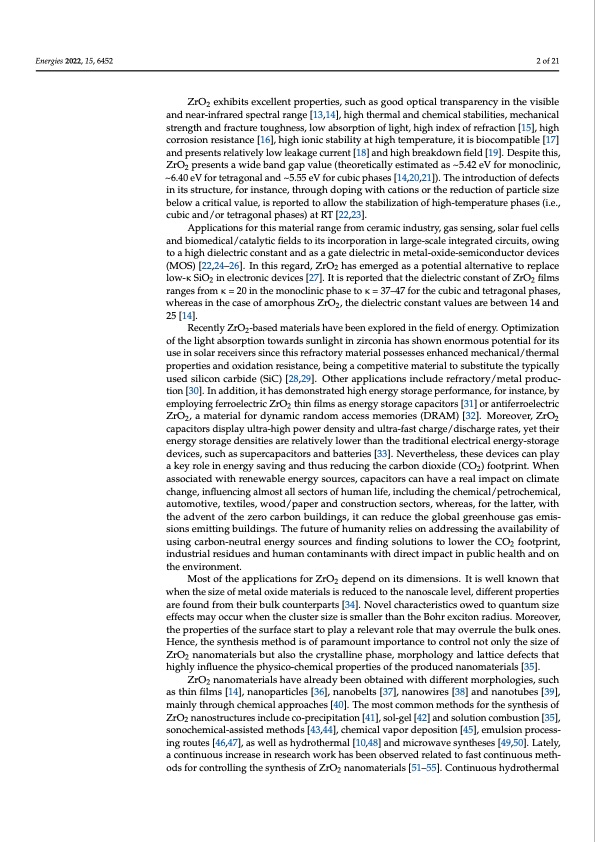
PDF Publication Title:
Text from PDF Page: 002
Energies 2022, 15, 6452 2 of 21 ZrO2 exhibits excellent properties, such as good optical transparency in the visible and near-infrared spectral range [13,14], high thermal and chemical stabilities, mechanical strength and fracture toughness, low absorption of light, high index of refraction [15], high corrosion resistance [16], high ionic stability at high temperature, it is biocompatible [17] and presents relatively low leakage current [18] and high breakdown field [19]. Despite this, ZrO2 presents a wide band gap value (theoretically estimated as ~5.42 eV for monoclinic, ~6.40 eV for tetragonal and ~5.55 eV for cubic phases [14,20,21]). The introduction of defects in its structure, for instance, through doping with cations or the reduction of particle size below a critical value, is reported to allow the stabilization of high-temperature phases (i.e., cubic and/or tetragonal phases) at RT [22,23]. Applications for this material range from ceramic industry, gas sensing, solar fuel cells and biomedical/catalytic fields to its incorporation in large-scale integrated circuits, owing to a high dielectric constant and as a gate dielectric in metal-oxide-semiconductor devices (MOS) [22,24–26]. In this regard, ZrO2 has emerged as a potential alternative to replace low-κ SiO2 in electronic devices [27]. It is reported that the dielectric constant of ZrO2 films ranges from κ = 20 in the monoclinic phase to κ = 37–47 for the cubic and tetragonal phases, whereas in the case of amorphous ZrO2, the dielectric constant values are between 14 and 25 [14]. Recently ZrO2-based materials have been explored in the field of energy. Optimization of the light absorption towards sunlight in zirconia has shown enormous potential for its use in solar receivers since this refractory material possesses enhanced mechanical/thermal properties and oxidation resistance, being a competitive material to substitute the typically used silicon carbide (SiC) [28,29]. Other applications include refractory/metal produc- tion [30]. In addition, it has demonstrated high energy storage performance, for instance, by employing ferroelectric ZrO2 thin films as energy storage capacitors [31] or antiferroelectric ZrO2, a material for dynamic random access memories (DRAM) [32]. Moreover, ZrO2 capacitors display ultra-high power density and ultra-fast charge/discharge rates, yet their energy storage densities are relatively lower than the traditional electrical energy-storage devices, such as supercapacitors and batteries [33]. Nevertheless, these devices can play a key role in energy saving and thus reducing the carbon dioxide (CO2) footprint. When associated with renewable energy sources, capacitors can have a real impact on climate change, influencing almost all sectors of human life, including the chemical/petrochemical, automotive, textiles, wood/paper and construction sectors, whereas, for the latter, with the advent of the zero carbon buildings, it can reduce the global greenhouse gas emis- sions emitting buildings. The future of humanity relies on addressing the availability of using carbon-neutral energy sources and finding solutions to lower the CO2 footprint, industrial residues and human contaminants with direct impact in public health and on the environment. Most of the applications for ZrO2 depend on its dimensions. It is well known that when the size of metal oxide materials is reduced to the nanoscale level, different properties are found from their bulk counterparts [34]. Novel characteristics owed to quantum size effects may occur when the cluster size is smaller than the Bohr exciton radius. Moreover, the properties of the surface start to play a relevant role that may overrule the bulk ones. Hence, the synthesis method is of paramount importance to control not only the size of ZrO2 nanomaterials but also the crystalline phase, morphology and lattice defects that highly influence the physico-chemical properties of the produced nanomaterials [35]. ZrO2 nanomaterials have already been obtained with different morphologies, such as thin films [14], nanoparticles [36], nanobelts [37], nanowires [38] and nanotubes [39], mainly through chemical approaches [40]. The most common methods for the synthesis of ZrO2 nanostructures include co-precipitation [41], sol-gel [42] and solution combustion [35], sonochemical-assisted methods [43,44], chemical vapor deposition [45], emulsion process- ing routes [46,47], as well as hydrothermal [10,48] and microwave syntheses [49,50]. Lately, a continuous increase in research work has been observed related to fast continuous meth- ods for controlling the synthesis of ZrO2 nanomaterials [51–55]. Continuous hydrothermalPDF Image | Comparison between Solution-Based Synthesis Methods of ZrO2

PDF Search Title:
Comparison between Solution-Based Synthesis Methods of ZrO2Original File Name Searched:
energies-15-06452.pdfDIY PDF Search: Google It | Yahoo | Bing
Turbine and System Plans CAD CAM: Special for this month, any plans are $10,000 for complete Cad/Cam blueprints. License is for one build. Try before you buy a production license. More Info
Waste Heat Power Technology: Organic Rankine Cycle uses waste heat to make electricity, shaft horsepower and cooling. More Info
All Turbine and System Products: Infinity Turbine ORD systems, turbine generator sets, build plans and more to use your waste heat from 30C to 100C. More Info
CO2 Phase Change Demonstrator: CO2 goes supercritical at 30 C. This is a experimental platform which you can use to demonstrate phase change with low heat. Includes integration area for small CO2 turbine, static generator, and more. This can also be used for a GTL Gas to Liquids experimental platform. More Info
Introducing the Infinity Turbine Products Infinity Turbine develops and builds systems for making power from waste heat. It also is working on innovative strategies for storing, making, and deploying energy. More Info
Need Strategy? Use our Consulting and analyst services Infinity Turbine LLC is pleased to announce its consulting and analyst services. We have worked in the renewable energy industry as a researcher, developing sales and markets, along with may inventions and innovations. More Info
Made in USA with Global Energy Millennial Web Engine These pages were made with the Global Energy Web PDF Engine using Filemaker (Claris) software.
Sand Battery Sand and Paraffin for TES Thermo Energy Storage More Info
| CONTACT TEL: 608-238-6001 Email: greg@infinityturbine.com | RSS | AMP |